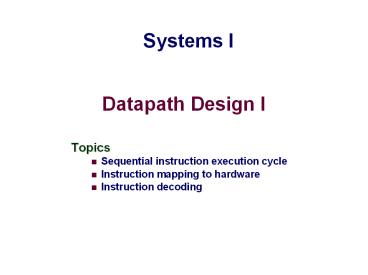Datapath Design I - PowerPoint PPT Presentation
1 / 18
Title:
Datapath Design I
Description:
Systems I Datapath Design I Topics Sequential instruction execution cycle Instruction mapping to hardware Instruction decoding – PowerPoint PPT presentation
Number of Views:121
Avg rating:3.0/5.0
Title: Datapath Design I
1
Datapath Design I
Systems I
- Topics
- Sequential instruction execution cycle
- Instruction mapping to hardware
- Instruction decoding
2
Overview
- How do we build a digital computer?
- Hardware building blocks digital logic
primitives - Instruction set architecture what HW must
implement - Principled approach
- Hardware designed to implement one instruction at
a time - Plus connect to next instruction
- Decompose each instruction into a series of steps
- Expect that most steps will be common to many
instructions - Extend design from there
- Overlap execution of multiple instructions
(pipelining) - Later in this course
- Parallel execution of many instructions
- In more advanced computer architecture course
3
Y86 Instruction Set
4
Building Blocks
- Combinational Logic
- Compute Boolean functions of inputs
- Continuously respond to input changes
- Operate on data and implement control
- Storage Elements
- Store bits
- Addressable memories
- Non-addressable registers
- Loaded only as clock rises
5
Hardware Control Language
- Very simple hardware description language
- Can only express limited aspects of hardware
operation - Parts we want to explore and modify
- Data Types
- bool Boolean
- a, b, c,
- int words
- A, B, C,
- Does not specify word size---bytes, 32-bit words,
- Statements
- bool a bool-expr
- int A int-expr
6
HCL Operations
- Classify by type of value returned
- Boolean Expressions
- Logic Operations
- a b, a b, !a
- Word Comparisons
- A B, A ! B, A lt B, A lt B, A gt B, A gt B
- Set Membership
- A in B, C, D
- Same as A B A C A D
- Word Expressions
- Case expressions
- a A b B c C
- Evaluate test expressions a, b, c, in sequence
- Return word expression A, B, C, for first
successful test
7
An Abstract Processor
- What does a processor do?
- Consider a processor that only executes nops.
- void be_a_processor(unsigned int pc,
- unsigned char mem)
- while(1)
- char opcode mempc
- assert(opcode NOP)
- pc pc 1
Fetch
Decode
Execute
8
An Abstract Processor
- Executes nops and absolute jumps
- void be_a_processor(unsigned int pc,
- unsigned char mem)
- while(1)
- char opcode mempc
- switch (opcode)
- case NOP pc
- case JMP pc (int)mem(pc1)
Missing execute and memory access
9
SEQ Hardware Structure
newPC
PC
valE
,
valM
Write back
valM
- State
- Program counter register (PC)
- Condition code register (CC)
- Register File
- Memories
- Access same memory space
- Data for reading/writing program data
- Instruction for reading instructions
- Instruction Flow
- Read instruction at address specified by PC
- Process through stages
- Update program counter
Data
Data
Memory
memory
memory
Addr
, Data
valE
CC
CC
ALU
ALU
Execute
Bch
aluA
,
aluB
valA
,
valB
srcA
,
srcB
Decode
A
B
A
B
dstA
,
dstB
Register
M
Register
M
Register
Register
file
file
file
file
E
E
icode
ifun
valP
rA
,
rB
valC
Instruction
PC
Instruction
PC
memory
increment
memory
increment
Fetch
PC
10
SEQ Stages
newPC
PC
valE
,
valM
Write back
valM
- Fetch
- Read instruction from instruction memory
- Decode
- Read program registers
- Execute
- Compute value or address
- Memory
- Read or write data
- Write Back
- Write program registers
- PC
- Update program counter
Data
Data
Memory
memory
memory
Addr
, Data
valE
CC
CC
ALU
ALU
Execute
Bch
aluA
,
aluB
valA
,
valB
srcA
,
srcB
Decode
A
B
A
B
dstA
,
dstB
Register
M
Register
M
Register
Register
file
file
file
file
E
E
icode
ifun
valP
rA
,
rB
valC
Instruction
PC
Instruction
PC
memory
increment
memory
increment
Fetch
PC
11
Instruction Decoding
- Instruction Format
- Instruction byte icodeifun
- Optional register byte rArB
- Optional constant word valC
12
Executing Arith./Logical Operation
- Fetch
- Read 2 bytes
- Decode
- Read operand registers
- Execute
- Perform operation
- Set condition codes
- Memory
- Do nothing
- Write back
- Update register
- PC Update
- Increment PC by 2
- Why?
13
Stage Computation Arith/Log. Ops
OPl rA, rB
- Formulate instruction execution as sequence of
simple steps - Use same general form for all instructions
14
Executing rmmovl
- Fetch
- Read 6 bytes
- Decode
- Read operand registers
- Execute
- Compute effective address
- Memory
- Write to memory
- Write back
- Do nothing
- PC Update
- Increment PC by 6
15
Stage Computation rmmovl
rmmovl rA, D(rB)
- Use ALU for address computation
16
Executing popl
- Fetch
- Read 2 bytes
- Decode
- Read stack pointer
- Execute
- Increment stack pointer by 4
- Memory
- Read from old stack pointer
- Write back
- Update stack pointer
- Write result to register
- PC Update
- Increment PC by 2
17
Stage Computation popl
popl rA
- Use ALU to increment stack pointer
- Must update two registers
- Popped value
- New stack pointer
18
Summary
- Today
- Sequential instruction execution cycle
- Instruction mapping to hardware
- Instruction decoding
- Next time
- Control flow instructions
- Hardware for sequential machine (SEQ)

